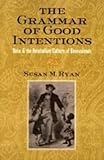The Grammar of Good Intentions : Race and the Antebellum Culture of Benevolence / Susan M. Ryan.
Material type: TextPublisher: Ithaca, NY : Cornell University Press, [2018]Copyright date: ©2004Description: 1 online resource (256 p.) : 10 halftonesContent type:
TextPublisher: Ithaca, NY : Cornell University Press, [2018]Copyright date: ©2004Description: 1 online resource (256 p.) : 10 halftonesContent type: - 9781501718564
- 810.9/355 23
- online - DeGruyter
| Item type | Current library | Call number | URL | Status | Notes | Barcode | |
|---|---|---|---|---|---|---|---|
 eBook
eBook
|
Biblioteca "Angelicum" Pont. Univ. S.Tommaso d'Aquino Nuvola online | online - DeGruyter (Browse shelf(Opens below)) | Online access | Not for loan (Accesso limitato) | Accesso per gli utenti autorizzati / Access for authorized users | (dgr)9781501718564 |
Browsing Biblioteca "Angelicum" Pont. Univ. S.Tommaso d'Aquino shelves, Shelving location: Nuvola online Close shelf browser (Hides shelf browser)

|

|

|

|

|

|

|
||
| online - DeGruyter Unnaturally French : Foreign Citizens in the Old Regime and After / | online - DeGruyter The Shorter Writings / | online - DeGruyter Saudi Arabia : The Ceaseless Quest for Security / | online - DeGruyter The Grammar of Good Intentions : Race and the Antebellum Culture of Benevolence / | online - DeGruyter New Working-Class Studies / | online - DeGruyter Reading Psychoanalysis : Freud, Rank, Ferenczi, Groddeck / | online - DeGruyter Reading Gertrude Stein : Body, Text, Gnosis / |
Frontmatter -- Contents -- Illustrations -- Acknowledgments -- INTRODUCTION. Toward a Cultural History of Good Intentions -- CHAPTER ONE. Benevolent Violence: Indian Removal and the Contest of National Character -- CHAPTER TWO. Misgivings: Duplicity and Need in Melville's Late Fiction -- CHAPTER THREE. The Racial Polities of Self-Reliance -- CHAPTER FOUR. Pedagogies of Emancipation -- CHAPTER FIVE. Charity Begins at Home: Stowe’s Antislavery Novels and the Forms of Benevolent Citizenship -- CHAPTER SIX . “Save Us from Our Friends”: Free African Americans and the Culture of Benevolence -- EPILOGUE. The Afterlife of Benevolent Citizenship -- Notes -- Index
restricted access online access with authorization star
http://purl.org/coar/access_right/c_16ec
Susan M. Ryan explores antebellum Americans' preoccupation with the language and practice of benevolence. Drawing on a variety of cultural and literary texts, she traces how people working and writing within social reform movements—and their outspoken opponents—helped solidify racial and class ideologies that ultimately marginalized even the most "deserving" poor. "The links between race and the relations of benevolence occasioned much soul-searching among antebellum Americans," Ryan explains. "In a period of heated public debate over issues such as slavery, Indian removal, and non-Protestant immigration, the categories of blackness, Indianness, and a generic 'foreignness' came to signify, for many whites, need itself."Ryan puts familiar literary works such as Herman Melville's The Confidence-Man, Frederick Douglass's My Bondage and My Freedom, and Harriet Beecher Stowe's Uncle Tom's Cabin back into dialogue with a broad range of print materials: the reports of charity societies, African American and Native American newspapers, juvenile fiction, travel writing, cartoons, sermons, and tract literature. In the process, she dispels the myth that authors usually classified as literary were responding to a simple and unquestioned cult of benevolence. Rather, she contends, they were participating in the complex and often rancorous debates occurring within the broader culture over how good intentions should be expressed and enacted.Ryan's inquiry into the antebellum culture of benevolence has implications for contemporary U.S. society, resonating especially with recent debates over welfare reform, the politics of compassionate conservatism, and representations of "welfare queens" and violent urban youth. As Ryan writes, "The conversations that this book reconstructs remind us of our ongoing participation in the national ritual of laying claim to good intentions."
Mode of access: Internet via World Wide Web.
In English.
Description based on online resource; title from PDF title page (publisher's Web site, viewed 26. Apr 2024)


